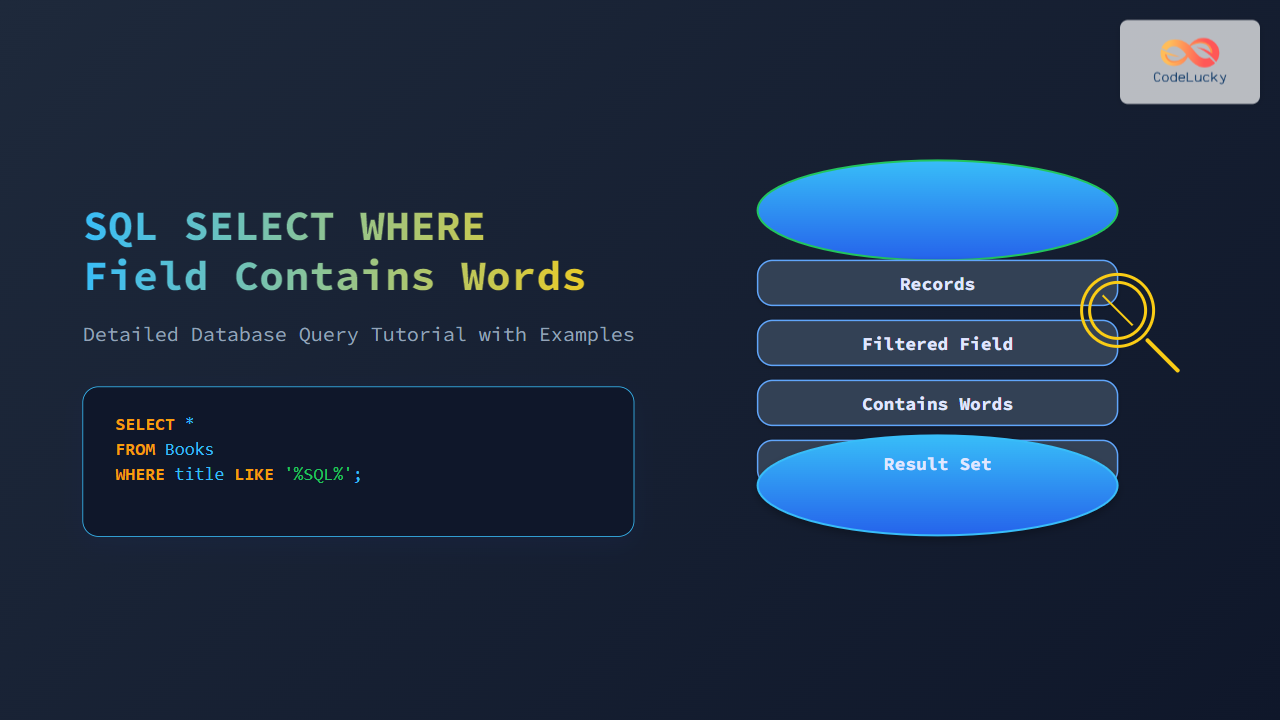In the world of database management, ensuring data integrity is paramount. One of the key aspects of maintaining data integrity is preventing duplicate entries in your tables. This is where the SQL UNIQUE constraint comes into play. 🛡️
The UNIQUE constraint is a powerful tool that ensures that all values in a column (or a set of columns) are distinct. It's like a vigilant guardian, standing watch over your data and rejecting any attempts to insert duplicate values. Let's dive deep into the world of UNIQUE constraints and explore how they can help you maintain clean, reliable data. 🏊♂️
Understanding the UNIQUE Constraint
The UNIQUE constraint is a rule that you can apply to a column or a combination of columns in a table. When a UNIQUE constraint is in place, it guarantees that no two rows in the table can have the same value in the specified column(s). 🔒
Here's a simple analogy: Think of a UNIQUE constraint as a bouncer at an exclusive club. Just as the bouncer ensures that each person entering the club is unique and not a duplicate of someone already inside, the UNIQUE constraint makes sure each value in a column is distinct from all others.
Syntax for Creating a UNIQUE Constraint
The syntax for creating a UNIQUE constraint can vary slightly depending on whether you're creating it along with the table or adding it to an existing table. Let's look at both scenarios:
Creating a UNIQUE Constraint with a New Table
CREATE TABLE employees (
employee_id INT PRIMARY KEY,
email VARCHAR(100) UNIQUE,
first_name VARCHAR(50),
last_name VARCHAR(50)
);
In this example, we're creating a table called employees with a UNIQUE constraint on the email column. This ensures that no two employees can have the same email address. 📧
Adding a UNIQUE Constraint to an Existing Table
ALTER TABLE employees
ADD CONSTRAINT unique_email UNIQUE (email);
This SQL statement adds a UNIQUE constraint named unique_email to the email column of an existing employees table.
Practical Examples of UNIQUE Constraints
Let's explore some practical scenarios where UNIQUE constraints can be incredibly useful. We'll use a variety of examples to illustrate different aspects of UNIQUE constraints. 🎭
Example 1: Preventing Duplicate Product Codes
Imagine you're managing an inventory system for a retail store. Each product has a unique product code, and you want to ensure that no two products can have the same code.
CREATE TABLE products (
product_id INT PRIMARY KEY,
product_code VARCHAR(20) UNIQUE,
product_name VARCHAR(100),
price DECIMAL(10, 2)
);
Now, let's try to insert some data:
INSERT INTO products (product_id, product_code, product_name, price)
VALUES
(1, 'ABC123', 'Widget A', 9.99),
(2, 'DEF456', 'Gadget B', 19.99),
(3, 'ABC123', 'Gizmo C', 14.99); -- This will fail due to duplicate product_code
The third INSERT statement will fail because it violates the UNIQUE constraint on product_code. The database will return an error message similar to:
Error: Duplicate entry 'ABC123' for key 'product_code'
This prevents accidental duplication of product codes, maintaining the integrity of your inventory system. 🛒
Example 2: Ensuring Unique User Handles
Social media platforms often use unique user handles or usernames. Let's create a table for user profiles with a UNIQUE constraint on the user handle:
CREATE TABLE user_profiles (
user_id INT PRIMARY KEY,
user_handle VARCHAR(50) UNIQUE,
display_name VARCHAR(100),
email VARCHAR(100)
);
Now, let's insert some user data:
INSERT INTO user_profiles (user_id, user_handle, display_name, email)
VALUES
(1, '@johndoe', 'John Doe', '[email protected]'),
(2, '@janedoe', 'Jane Doe', '[email protected]'),
(3, '@johndoe', 'John Smith', '[email protected]'); -- This will fail
The third INSERT statement will fail because '@johndoe' is already taken. This ensures that each user has a unique handle, preventing confusion and maintaining the integrity of user identities. 🆔
Example 3: Composite UNIQUE Constraint
Sometimes, you might want to ensure uniqueness based on a combination of columns. For example, in a school database, you might want to ensure that no two students in the same grade have the same student number.
CREATE TABLE students (
student_id INT PRIMARY KEY,
grade INT,
student_number INT,
first_name VARCHAR(50),
last_name VARCHAR(50),
CONSTRAINT unique_grade_student_number UNIQUE (grade, student_number)
);
Let's insert some student data:
INSERT INTO students (student_id, grade, student_number, first_name, last_name)
VALUES
(1, 9, 1001, 'Alice', 'Johnson'),
(2, 10, 1001, 'Bob', 'Smith'), -- This is OK because it's a different grade
(3, 9, 1002, 'Charlie', 'Brown'),
(4, 9, 1001, 'David', 'Lee'); -- This will fail
The fourth INSERT statement will fail because there's already a student in grade 9 with student number 1001. This composite UNIQUE constraint allows for the same student number to be used in different grades, but prevents duplicate student numbers within the same grade. 🏫
Example 4: UNIQUE Constraint with NULL Values
It's important to note that most database systems treat NULL values as unique. This means you can have multiple NULL values in a column with a UNIQUE constraint. Let's see this in action with a table of book reviews:
CREATE TABLE book_reviews (
review_id INT PRIMARY KEY,
book_isbn VARCHAR(13) UNIQUE,
reviewer_name VARCHAR(100),
rating INT,
review_text TEXT
);
Now, let's insert some reviews:
INSERT INTO book_reviews (review_id, book_isbn, reviewer_name, rating, review_text)
VALUES
(1, '9780141439518', 'John', 5, 'A classic masterpiece!'),
(2, NULL, 'Jane', 4, 'Great read, highly recommended.'),
(3, NULL, 'Bob', 3, 'Interesting plot, but slow pacing.');
All of these INSERT statements will succeed, even though we have two NULL values in the book_isbn column. This can be useful when you want to allow for optional unique identifiers. 📚
Handling UNIQUE Constraint Violations
When you try to insert or update data that violates a UNIQUE constraint, the database will reject the operation and return an error. However, there are ways to handle these situations gracefully in your applications.
Using INSERT … ON DUPLICATE KEY UPDATE
In MySQL, you can use the INSERT ... ON DUPLICATE KEY UPDATE statement to handle potential UNIQUE constraint violations:
INSERT INTO products (product_id, product_code, product_name, price)
VALUES (4, 'GHI789', 'Super Widget', 29.99)
ON DUPLICATE KEY UPDATE
product_name = VALUES(product_name),
price = VALUES(price);
This statement will insert a new row if the product_code doesn't exist, or update the existing row if it does. This can be useful for "upsert" operations where you want to insert or update based on the uniqueness of a value. 🔄
Using MERGE in SQL Server
SQL Server provides the MERGE statement, which can be used to handle UNIQUE constraint violations:
MERGE INTO products AS target
USING (SELECT 4 AS product_id, 'GHI789' AS product_code, 'Super Widget' AS product_name, 29.99 AS price) AS source
ON (target.product_code = source.product_code)
WHEN MATCHED THEN
UPDATE SET product_name = source.product_name, price = source.price
WHEN NOT MATCHED THEN
INSERT (product_id, product_code, product_name, price)
VALUES (source.product_id, source.product_code, source.product_name, source.price);
This MERGE statement will update the existing row if the product_code exists, or insert a new row if it doesn't. 🔀
Best Practices for Using UNIQUE Constraints
When working with UNIQUE constraints, keep these best practices in mind:
-
Choose appropriate columns: Apply UNIQUE constraints to columns (or combinations of columns) that should genuinely be unique, such as email addresses, product codes, or user handles. 🎯
-
Consider performance: UNIQUE constraints create an index on the specified column(s), which can improve query performance for searches on those columns but may slightly slow down inserts and updates. 🏎️
-
Use meaningful names: When adding UNIQUE constraints to existing tables, use meaningful names that describe the purpose of the constraint. This makes your schema more self-documenting. 📝
-
Handle violations gracefully: In your application code, be prepared to handle UNIQUE constraint violations. Provide meaningful error messages to users when they attempt to insert duplicate values. 🛠️
-
Consider case sensitivity: Be aware that the behavior of UNIQUE constraints with regard to case sensitivity can vary depending on your database system and collation settings. 🔠
-
Use with NULL values wisely: Remember that multiple NULL values are typically allowed in a column with a UNIQUE constraint. If this is not desired, consider combining the UNIQUE constraint with a NOT NULL constraint. ❗
Conclusion
The UNIQUE constraint is a powerful tool in your SQL toolkit for maintaining data integrity. By preventing duplicate values in specified columns, it helps ensure the accuracy and reliability of your data. Whether you're designing a new database or improving an existing one, consider where UNIQUE constraints can add value to your data model. 🏆
Remember, clean, well-structured data is the foundation of any robust database system. By leveraging UNIQUE constraints effectively, you're taking a significant step towards achieving that goal. Happy coding, and may your data always be unique! 🚀



















